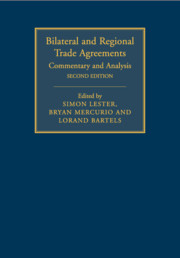Book contents
- Frontmatter
- Contents
- List of contributors
- Foreword
- Table of Cases
- Table of treaties and international agreements
- List of abbreviations
- Part I Introduction
- Part II Economics and politics of PTAs
- 2 The economics of PTAs
- 3 The political economy of PTAs
- 4 Bilateral and plurilateral PTAs
- Part III Relationship with WTO and international law
- Part IV Legal aspects of PTAs: A comparative analysis
- Index
3 - The political economy of PTAs
from Part II - Economics and politics of PTAs
Published online by Cambridge University Press: 05 October 2015
- Frontmatter
- Contents
- List of contributors
- Foreword
- Table of Cases
- Table of treaties and international agreements
- List of abbreviations
- Part I Introduction
- Part II Economics and politics of PTAs
- 2 The economics of PTAs
- 3 The political economy of PTAs
- 4 Bilateral and plurilateral PTAs
- Part III Relationship with WTO and international law
- Part IV Legal aspects of PTAs: A comparative analysis
- Index
Summary
I. Introduction: Re-thinking the paradigm of bilateral/regional trade agreements
Why do countries conclude bilateral/regional trade agreements? Numerous researchers have sought to answer this question, most often through creating a typology of the agreements. Such efforts, however, have been in vain. A bilateral/regional trade agreement is rarely, if ever, based on a single motive, and two or more parties to an agreement can often have different and sometimes even conflicting objectives (e.g., one seeking market access and the other political support). In fact, different actors within each country itself can also have different objectives (e.g., one sector seeking trade creation whilst another trade diversion). Thus, any typology is bound to create artificial categories, and would not necessarily give a proper or accurate answer to the original question.
Sometimes, countries fall into a similar trap by trying to explain the rationale behind their bilateral/regional trade policy. For example, in its ‘Global Europe’ Communication (2006), the European Commission acknowledged that it had been predominantly motivated by political considerations in concluding trade agreements with countries that were candidates for European Union (EU) membership (with the exception of Mexico, South Africa, and Chile). Although such a policy was in line with the EU's neighbourhood and development objectives, it did little to serve the EU's central trade interests. The EU therefore designed a new strategy, where economics was restored as the chief criterion for future bilateral agreements. Future partners would be selected on the basis of:
• their market potential (economic size and growth),
• their level of protection against EU export interests (tariffs and non-tariff barriers), and
• the state of negotiations with EU competitors (to measure the likely impact of a bilateral agreement with a competitor on EU markets and economy, as well as the risk of erosion of the preferential access to EU markets currently enjoyed by the EU's neighbouring and developing country partners).
The Commission concluded that the Association of Southeast Asian Nations (ASEAN), Korea, and the Common Market of the Southern Cone (MERCOSUR) were ‘priorities’; while India, Russia, and the Gulf Co-operation Council (GCC) were ‘of direct interest’; and China, although meeting the criteria, ‘required special attention’ because of both the potential and risks it presented.
- Type
- Chapter
- Information
- Bilateral and Regional Trade AgreementsCommentary and Analysis, pp. 28 - 52Publisher: Cambridge University PressPrint publication year: 2016



